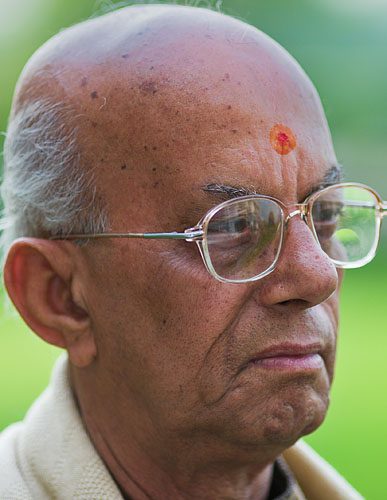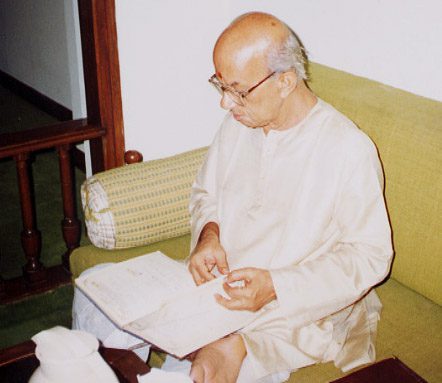by Rajan P. Parrikar
A version of this tribute was published on the occasion of Ramrang’s 75th birthday felicitation event held in New Delhi on August 16, 2003
[Update: Pandit Ramashreya Jha “Ramrang” passed away on January 1, 2009. He was 80.]
Namashkar.
Today we have assembled under one roof to honour Ramashreya Jha “Ramrang” and to reflect on the oeuvre of this rara avis who has dedicated his life to the realization of the highest ideals decorating the musical pathways of our land. We celebrate this apostle who, through years of ardent study and contemplation, has enlarged our understanding and knowledge of raga and clarified its foundations in the realm of both shashtra and performance. For 60 years Ramashreya Jha has exerted his critical and creative faculties, coursed through the demesne of his formidable intellect, and culled melodic objects of lasting value only to plant them back in the garden of our imagination. In so doing, Ramrang has made our world more beautiful and more meaningful. It is now our turn to punctuate his musical odyssey with a collective expression of gratitude, affection and admiration.

Ramashreya Jha “Ramrang”
(© Rajan P. Parrikar)
To think of Ramrang is to think of his fanatical love of learning, of the unusual depth and width of his knowledge, of his high standards of excellence, of his remarkable ingenuity, and above all, of the passion and joie de vivre with which he disburses the fruits of his endeavours. A sharp focus in life is a benediction granted to only the most fortunate among us. Music has been the sole and defining hinge around which Ramrang’s life has revolved. It has been his raison d’etre, his anodyne, and his refuge from “the crowded trivialities of everyday life” (to paraphrase Rabindranath Thakur). The extent of this monomania is suggested by his own occasional utterance: “aur kuchh na aataa hai na kartaa hoon.”
Sangeetacharya Ramashreya Jha “Ramrang” was born on August 11, 1928, in Darbhanga in the Mithila region of Bihar, once a thriving centre of dhrupad music. His father Sukhdev Jha and his uncle Madhusudan Jha were his early mentors. But his final calling was nurtured and honed during the 25 years he spent in Allahabad at the ashram of his distinguished guru Bholanath Bhatt. Allahabad was to remain his karmabhoomi. Ramrang also had the benefit of instruction from other vidwans such as B.N. Thakar of Allahabad and Habib Khan of Kirana. Around 15 years of his youth were spent with a drama company in Varanasi. This experience helped widen his musical vistas and attune him to the pulse of the rustic antecedents of our Art music. In 1968 he was appointed to the faculty of Allahabad University and later, in 1980, elevated to the position of Head of the Music Department. This singular move by the University was in recognition of genuine merit for Ramrang holds no formal degrees. He retired from active professorial duty in 1989.
Ramrang’s composite musical personality unravels into four interrelated strands that are briefly touched upon:

Ramashreya Jha “Ramrang” in Goa (1999)
(a) He is a shastrakara of the highest class and the fruits of his lifelong meditations into the nature of raga constitute the five published volumes of Abhinava Geetanjali. These classics represent a signal contribution to Indian music, dazzling us with the keenness of their author’s intellect, revealing his extensive knowledge, agility of mind, and quality of scholarship. The volumes disclose an unusual talent in formulating and communicating ideas elegantly and simply. The insights and critical analyses of ragas together with hundreds of Ramrang’s own high-quality musical compositions purveyed impel us towards the inescapable verdict: Ramashreya Jha “Ramrang” is the Bhatkhande of our time.
(b) As a preeminent vaggeyakara, Ramrang’s fertile imagination, retentiveness and quickness of mind are the key strengths attending his creative impulse. He carries all the essential music in his head and it is always at hand for instant recall. A high quality bandish must represent the précis of a raga’s melodic content (lakshanas). A typical Ramrang composition goes farther: each word, swara and matra are tied together in a symbiotic melodic ecosystem of an aesthetic unity not usually found in your run-of-the-mill ‘traditional’ bandish. His compositions verily install him alongside the handful of supremely gifted musical minds in any generation to whom is vouchsafed the mantra of music. Among the earliest musicians to appreciate Jha-sahab’s erudition and come under the spell of his compositions was Jitendra Abhisheki who sang, popularized, and taught many of Ramrang’s bandishes. These compositions later found their way into the repertoire of several leading vocalists.

(c) As a performer, Ramrang’s gayaki is best appreciated by those with a grasp of the nuances of swara and raga. One listens to Ramrang not for his vocal gymnastics and high velocity tans – to be sure, he indulges in neither – but to drink from the wellspring of raganubhava. His is a lakshana-oriented approach. Even the familiar, well-worn ragas when refracted through Ramrang’s mental prism acquire a distinct conceptual body and flavour. Unlike most Hindustani renditions of the day, Ramrang does not believe in making short shrift of the text of the bandish. Instead, with his acute sense of the dramatic and the poetic, he reminds us of the values intrinsic to the older genre of dhrupad, marrying verse and swara with such felicity as to make the two seem inseparable. Ramrang’s creative acumen lies not only in his superbly conceived compositions but also in his manner of uccharana accompanying the build-up of the raga edifice (known in the trade as asthaai bharnaa) from the skeletal bandish.

(d) Ramrang’s final facet appertains to his role as an educator. He has trained and counseled several students over the years. His senior disciple, Dr. Geeta Banerjee, is an eminent author, scholar and musician who later succeeded him as Head of the Music Department at Allahabad University. Another pupil, Shubha Mudgal, has attained international recognition. On this website we have adduced numerous examples of Ramrang’s talents at exposition and the inspirited delivery he brings to it. His discourses have come to be highly valued as both pedagogic masterpieces and as vignettes of aesthetic delight. (Update: In 2005 the President of India conferred on him the Sangeet Natak Akademi Award for his contributions to music.)
Today, as he has done for the past 6 decades, Ramrang spends his waking moments immersed in the contemplation and creation of music. True to his calling, Ramrang’s intellectual wanderlust shows no sign of abating; every day turns in a new insight or a new asthai. In this context we are reminded of Einstein who famously observed: “Only in Science and Art are we permitted to remain children all our lives.”
Ramrang has spent most of his musical life in relative isolation, away from the glare of public adulation, and on the fringes of the community of active performing musicians. This is entirely in keeping with his character and inner conviction that music is a lifelong sadhana requiring of self-discipline. In summing up the musical life of Ramashreya Jha “Ramrang,” the understated flourish of Professor G.H. Hardy comes to mind: ”Whatever we do may be small, but it has a certain character of permanence; and to have produced anything of the slightest permanent interest…is to have done something utterly beyond the powers of the vast majority of men.” (A Mathematician’s Apology).
